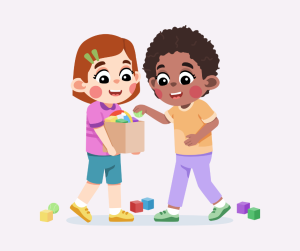Why Compliance Isn’t the Same as Understanding Behaviour
In the classroom, it’s tempting to see “good behaviour” as children sitting quietly, following routines, and doing what they’re told. While compliance does help keep a learning environment calm, it doesn’t always reflect what children have truly learned about themselves, others, or the reasons behind expectations. In order to improve behaviour in early years and primary education it is important for children to understand their emotions.
As teachers, it’s important to distinguish between compliance and understanding behaviour if we want to build strong foundations for children’s social and emotional growth.
Compliance: Following Without Understanding
Compliance usually means that children are:
- Listening to and obeying adult instructions.
- Motivated by rewards, praise, or fear of consequences.
- Regulating themselves only when under adult supervision.
For example, a child who tidies up because the teacher says, “No story until the room is clean,” is compliant. While this creates a smooth classroom routine, the child hasn’t necessarily internalised why tidying matters.

Understanding Behaviour: Learning for Life
Understanding behaviour is about children making choices based on values, empathy, and self-regulation, not just instructions. This looks like:
- Recognising how their actions affect others.
- Managing emotions and impulses with increasing independence.
- Choosing positive behaviours even when adults aren’t watching.
For example, a child who chooses to help a peer tidy up because they see their friend is struggling demonstrates understanding.

Why Teachers Need to Aim Beyond Compliance
- Independent learners and citizens
Compliance works in the moment, but our goal is to nurture children who make thoughtful choices beyond the classroom. - Classroom climate
A compliance-only culture can create fear, stress, or “people-pleasing.” Encouraging understanding fosters respect, collaboration, and trust. - Behaviour as communication
Especially in the early years, behaviour often signals unmet needs (hunger, tiredness, frustration). Responding by building understanding, rather than demanding obedience, helps children feel secure and supported.

Practical Ways to Build Understanding in the Classroom
- Explain the “why”: Move beyond “Because I said so.” Link expectations to safety, kindness, or learning (e.g., “We walk inside so everyone stays safe”).
- Model positive behaviour: Children copy what they see. Consistent respect, calmness, and empathy from adults sets the tone.
- Use restorative conversations: After conflicts, guide children to reflect—“How did that make your friend feel? What could we do differently next time?”
- Teach emotional literacy: Incorporate naming feelings and strategies for self-regulation into daily routines.
- Promote problem-solving: Involve children in finding fair solutions, rather than adults always dictating outcomes.
Classroom Scenarios: Compliance vs. Understanding Behaviour
- Lining Up for Playtime
- Compliance: The teacher says, “Everyone line up quietly or we won’t go outside.” The children rush into line, some jostling, but they stand still because the teacher is watching.
- Understanding: The teacher explains, “When we line up calmly, everyone gets outside safely and quickly. Let’s see how we can help each other make space.” Children begin to remind each other to leave gaps and wait their turn, even when the teacher isn’t right next to them.

- Sharing Resources
- Compliance: A child hands over the scissors because the teacher tells them, “It’s not your turn—give them to Sam now.” The child complies, but grudgingly.
- Understanding: The teacher says, “Sam hasn’t had a turn yet. How could we make this fair?” The child pauses, thinks, and offers the scissors, recognising fairness rather than just obeying.
- Conflict on the Playground
- Compliance: After a pushing incident, the teacher says, “Say sorry to your friend.” The child mutters “sorry” without meaning it, eager to get back to play.
- Understanding: The teacher guides a restorative conversation: “What happened? How do you think your friend felt when you pushed them? What could you do to put things right?” The child chooses to apologise and checks if their friend is okay, showing genuine empathy.

- Classroom Rules
- Compliance: Rules are displayed and recited daily: “Sit still, no talking when the teacher is talking.” Children follow these rules only when the teacher is present to enforce them.
- Understanding: The teacher co-creates rules with the class: “What helps us to learn best together?” Children suggest listening to each other, keeping hands safe, and taking turns. They take ownership, reminding one another of the rules even when the teacher isn’t nearby.
- Tidy-Up Time
- Compliance: The teacher uses a countdown—“Five, four, three…”—and the children frantically put things away to avoid missing the next activity.
- Understanding: The teacher says, “When we tidy the blocks, we keep our classroom safe and ready for everyone to use tomorrow. Who wants to be responsible for the books, and who will help with the paints?” Children tidy because they understand the purpose and enjoy shared responsibility.
How Teachers Can Use These Scenarios
- For reflection: Ask yourself, “Am I aiming for short-term order, or long-term understanding?”
- In staff meetings: Use scenarios as discussion starters to explore strategies beyond compliance.
- With children: Adapt scenarios into circle-time role play to help pupils practice empathy, problem-solving, and reflection.
Final Thoughts
In early years and primary education, behaviour isn’t just about keeping the peace—it’s part of the curriculum for life. Compliance may give us order, but understanding behaviour gives children the skills to thrive socially, emotionally, and academically.
When we shift from “Do what I say” to “Let’s think about why we do this,” we help children develop empathy, resilience, and independence—qualities that will carry far beyond the classroom walls.
Download our Teaching Training Resources to help with scenarios and key takeaways.
